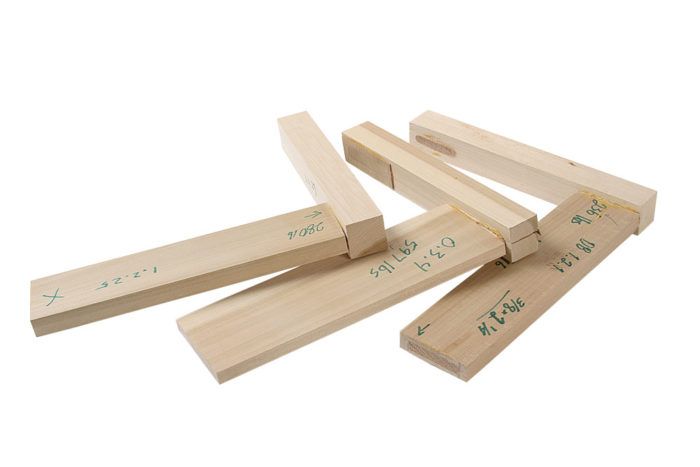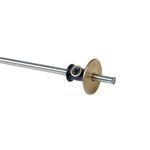Tips for Stronger Tenons
Make them bigger, reduce gaps, and don’t spare the glue
Synopsis: Wood researcher Dan Bollock broke more than 150 mortise-and-tenon joints of different widths, lengths, and thicknesses to see exactly how size, fit, and glue-up procedures affect the strength of the joint. He found that width plays the biggest role, but that length and thickness also make a huge difference. Not surprisingly, a joint that fits well is stronger. Also, the strongest glue bond was created by applying glue to both the mortise and the tenon.
A part of my job as a technician in a wood research laboratory, I test joinery, materials, and glues to see how they withstand the rigors of use and abuse. But I’m also a woodworker and furniture maker, so I have a vested interest in my research. Recently, I spent time studying the strength of various mortise-and-tenon joints, an important study as the joint is typically used in high-stress and load-bearing situations in chairs, tables, and case pieces. As part of the testing, we made and broke more than 150 mortise-and-tenons using a computerized hydraulic ram, called an Unaxial Load Frame, by MTS Systems.
We discovered not only that bigger is better, but also that the final joint fit and glue-up procedure affect the joint’s strength. Make them wide and long Most of the testing was done to determine how the size of the tenon affects its overall strength. For all three dimensions—width, length, and thickness—bigger directly equated to a stronger joint. For the width and length tests, we used 3⁄8-in.-thick tenons, a fairly common size. Increasing the width of the tenon had the biggest effect on the strength of the joint. As the width went from 1-1⁄4 in. to 2-1⁄4 in., the strength increased by 140%, and a 31⁄4-in.-wide tenon tested as 291% stronger than a 1-1⁄4-in.- wide tenon. We also discovered that increasing the tenon length added strength. Going from 3⁄4 in. to 1 in. resulted in a 53% gain, and increasing the length to 11⁄4 in. gave us an 85% increase in strength over the 3⁄4-in.-long tenon. As for tenon thickness, thicker is stronger. A 3⁄8-in.-thick tenon was 36% stronger and a 1⁄2-in.-thick tenon was 50% stronger than the 1⁄4-in.-thick tenon. But increasing thickness has a smaller effect than increasing width and length. Reduce gaps Another crucial factor in the joint’s strength was the fit of the tenon in the mortise. The tests proved that tight-fighting joinery is a must and that you can’t rely on glue to bridge even small gaps. Ideally, the gap around the tenon should be no more than 0.005 in.
For the full article, download the PDF below:
Fine Woodworking Recommended Products

Veritas Precision Square

Veritas Standard Wheel Marking Gauge

Starrett 4" Double Square























Comments
where is the PDF?
Not sure what happened there dyamwebz. It's back up.
I can easily make the mortises shown in the article, but I would have to hand cut the curved tenon edges. How does the author make such nicely curved tenons?? I m sure that must affect the strength.
I made the mortises with a router. A round over bit was used to make the tenons. Fine woodworking did a test about eight years ago comparing rounded tenons to square ones. The difference in strength was minor. Square ones work great too.
Did all samples fail the same way and what was the mode(s)?
There was an article in 2008 with much higher lb force achieved. A similar trend but 2 to 3 times higher force measurements. Do we know why?
Most samples failed when the tenon pulled out of the mortise slightly. There were some failures of the apron and a few of the legs broke.
The tests done in 2008 used cherry while I used yellow poplar. Also, the previous tests were loaded differently than my tests. Because of these factors the results cannot be compared but the general trends can.
Does the thickness of the mortise's sides have any bearing on the strength of the joint? A 3/8" tenon in a 3/4" thick piece (e.g. a web frame) leaves very little material to resist a blow against the flat surface of the piece. Because of this concern, would a 1/4" mortise and tenon be a good compromise?
Thanks for the article. It is appreciated.
The thickness of the sidewalls is important, especially if the two parts being joined together are the same thickness. In this case the tenon thickness should be equal to the sum of the side wall thicknesses. So if the parts are 3/4" thick, the tenon should be 3/8" thick and both side walls would be 3/16" thick.
Log in or create an account to post a comment.
Sign up Log in